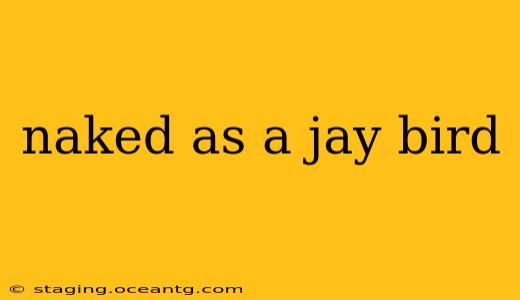The idiom "naked as a jaybird" paints a vivid picture of utter nakedness. But why a jaybird? This common expression, used to describe someone completely without clothes, holds a fascinating history rooted in the seemingly contradictory appearance of these birds. Let's delve into the origins and explore the nuances of this colorful phrase.
What does "naked as a jaybird" actually mean?
The phrase means completely nude, without any clothing whatsoever. It's a hyperbolic expression, emphasizing the lack of clothing in a humorous and memorable way. While no one is literally born without feathers, the idiom leverages the visual impact of a seemingly bare bird to convey a state of complete undress.
Why a jaybird? Aren't they feathered?
This is the crux of the idiom's charm. While jaybirds are certainly not naked, they have a unique appearance that, depending on the species, might seem less vibrantly feathered than other birds. Some species of jay have a relatively subdued plumage, particularly on their underparts, possibly leading to a perception of relative bareness compared to other brightly colored birds. It's this perceived lack of profuse feathers that forms the basis of the idiom's effectiveness. The image is one of less feather-cover than might be expected.
Where did the idiom originate?
Pinpointing the exact origin of "naked as a jaybird" is difficult, as its usage predates widespread documentation of idioms. However, its usage likely arose from a combination of folk observation and the slightly misleading appearance of some jay species. Its widespread adoption highlights the evocative power of the image and its easy memorability. The simplicity and effectiveness of the simile likely contributed to its popularity and enduring use.
Is the idiom used in other ways?
While primarily used to describe complete nudity, the idiom can, in informal contexts, be used metaphorically to describe a state of utter emptiness or destitution. For example, one might jokingly say a newly-cleaned house is "naked as a jaybird" implying a complete absence of clutter or furniture. This metaphorical extension shows the idiom's flexibility and adaptability to a wider range of contexts.
What are other idioms that describe nakedness?
Many other idioms describe nakedness, often with varying degrees of formality and cultural context. For example, "in the buff," "starkers," and "in one's birthday suit" are all common alternatives. Each possesses unique connotations and regional variations. The choice of idiom depends heavily on the context and desired tone.
Why is this idiom still used today?
The idiom's enduring popularity stems from its vivid imagery, humor, and concise nature. It effectively conveys a clear message with memorable phrasing. Its use continues because of its effectiveness in both literal and, to a lesser extent, metaphorical contexts. The simplicity and quirky nature of the idiom help it persist in modern language.
Conclusion: A feathered friend of figurative speech
The seemingly contradictory nature of "naked as a jaybird" is precisely what makes it such a successful idiom. Its roots in observation, however slightly skewed, coupled with its memorability and flexibility, ensure its continued use in everyday language for many years to come. It serves as a testament to the power of language to create memorable and effective imagery from unexpected sources.
